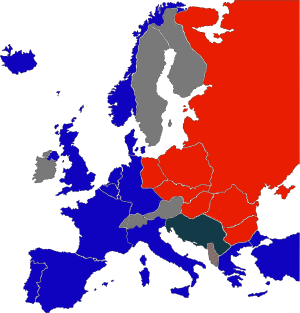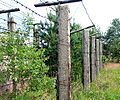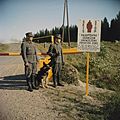Iron Curtain facts for kids

The Iron Curtain is a term related to the Cold War. It means the border between the states that were members of the Warsaw Pact (in Eastern Europe), and those that were not (then called The West).
The Iron Curtain was the political boundary dividing Europe into two separate areas from the end of World War II in 1945 until the end of the Cold War in 1991. The term symbolizes the efforts by the Soviet Union (USSR) to block itself and its satellite states from open contact with the West, its allies and neutral states.
On the east side of the Iron Curtain were the countries that were connected to or influenced by the Soviet Union, while on the west side were the countries that were NATO members, or connected to or influenced by the United States; or nominally neutral. Separate international economic and military alliances were developed on each side of the Iron Curtain. It later became a term for the 7,000-kilometre-long (4,300 mi) physical barrier of fences, walls, minefields, and watchtowers that divided the "east" and "west". The Berlin Wall was also part of this physical barrier.
The nations to the east of the Iron Curtain were:
Countries that made up the USSR were Russia, Belarus, Latvia, Ukraine, Estonia, Moldova, Armenia, Azerbaijan, Georgia, Uzbekistan, Kyrgyzstan, Tajikistan, Lithuania, Turkmenistan, and Kazakhstan. The events that demolished the Iron Curtain started with peaceful opposition in Poland, and continued into Hungary, East Germany, Bulgaria, and Czechoslovakia. Romania became the only socialist state in Europe to overthrow its government with violence.
The use of the term "Iron Curtain" as a metaphor for strict separation goes back at least as far as the early 19th century. It originally referred to fireproof curtains in theaters. The author Alexander Campbell used the term metaphorically in his 1945 book It's Your Empire, describing "an iron curtain of silence and censorship [which] has descended since the Japanese conquests of 1942". Its popularity as a Cold War symbol is attributed to its use in a speech Winston Churchill gave on 5 March 1946, in Fulton, Missouri.
The idea of the Iron Curtain was first made public by Winston Churchill, a famous Prime Minister of the United Kingdom during WW2, when invited to speak at American University by Harry S. Truman (the American president at the time). Churchill's speech was seen by Nikita Khrushchev; leader of the USSR from 1958 until 1964 as a declaration of war, as Churchill urged a struggle against the Soviet Union.
The idea of the Iron Curtain was referring to the separation of the communist Europe compared to the democratic west, it was the idea that what was happening in the satellite states and in Russia was secret to the rest of the world. Satellite state refers to a country being controlled by another, in this case Russia was controlling countries such as Hungary, Poland, Romania, Bulgaria and others which were previously controlled by Germany in WW2.
Images for kids
-
Remains of the "iron curtain" in Devínska Nová Ves, Bratislava (Slovakia)
-
Preserved part of "iron curtain" in the Czech Republic. A watchtower, dragon's teeth and electric security fence are visible.
-
Preserved section of the border between East Germany and West Germany called the "Little Berlin Wall" at Mödlareuth
-
Memorial in Budapest reads: "Iron Curtain 1949–1989"
-
Otto von Habsburg, who played a leading role in opening the Iron Curtain
See also
 In Spanish: Cortina de Hierro para niños
In Spanish: Cortina de Hierro para niños


















